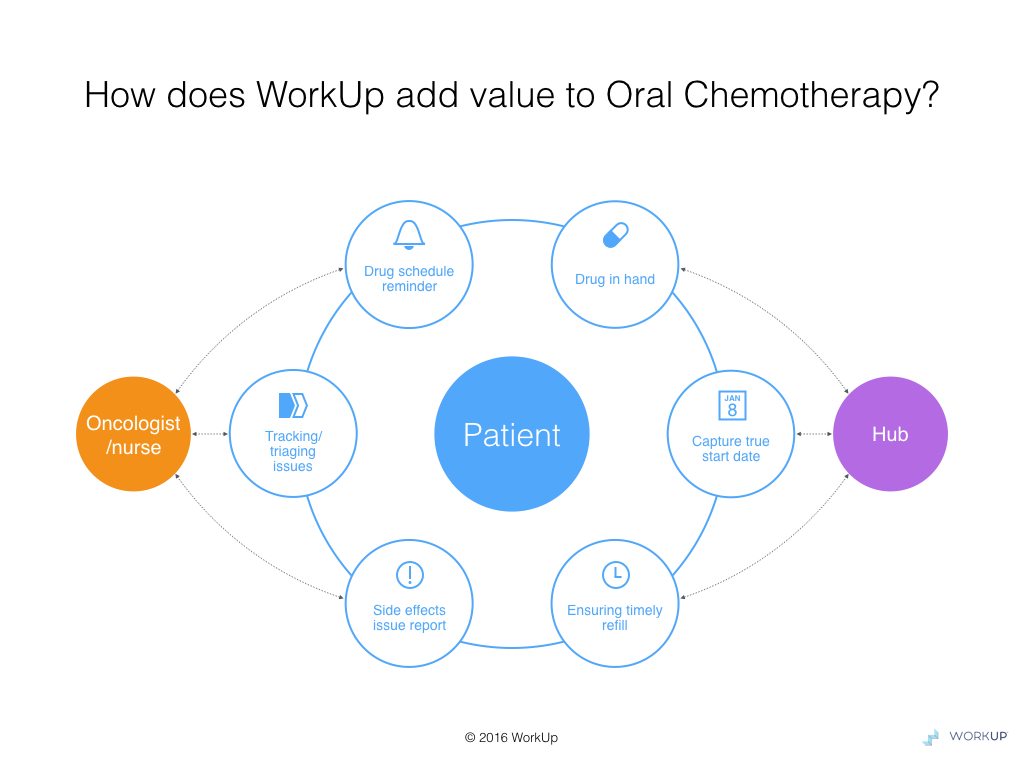WorkUp is a new startup out of New York City and Long Island, founded by Ken Engels, his wife Unha Engels, and Dr. Steven Eisenberg, which simplifies providers’ development of oral chemotherapy regimens, and improves the patient experience and quality of life with this key modality of cancer treatment. The company’s eponymous platform, launched last month, is a first-of-its-kind technology-based service platform for oncology practices, including an “app” to securely connect patients with practice staff, 24/7. The goal of the platform is to maximize the success of oral chemotherapy regimens by helping patients stay connected to their practices and truly adherent. On the front end, the adherence and compliance service—which is available to patients via a self-serve combination of TXT, text-to-speech, portal messaging, and smartphone app—guides patients through their treatment days and cycles (hour by hour), and enables oncology practices to monitor and address side effects, drug delivery or insurance issues that could interrupt treatment. Other benefits to oncology practices include back-end automation of compliance, delivery schedules, and updates to patient records—freeing providers to focus more time on effective patient care.
Ken Engels, co-founder and CEO, spoke with PM360 about how his background is an advantage in the healthcare industry, how the WorkUp platform will improve adherence and increase pharma revenues from oral chemotherapy sales by as much as 20%, and what’s next for the company.
PM360: What inspired you to start this company?
Ken Engels: Unha and I had a digital app agency before WorkUp, where we built digital products for big brands: Atari, FedEx, WebMD, etc. We were basically in the entertainment business. We were given the opportunity to shadow Dr. Steven Eisenberg, an oncologist in San Diego, and to see the oncology world from the inside. We decided this idea of better tools in day-to-day healthcare needed to be its own company, and we founded it with Steve.
How has that background in the consumer-side and entertainment helped as you’ve made this transition to healthcare?
We got competent at building big apps and projects. Part of our company’s approach is an expectation that software should do more, be more personal, and be more convenient. We know that a product is only as good as its engagement.
Let’s get into what WorkUp is actually doing to help oncologists and their patients?
Adherence is a team sport. WorkUp connects patients, providers, pharma, and payers. Specifically, WorkUp delivers a framework for oral chemotherapy compliance, e.g., regimen-specific medication scheduling. We want oncologists to be able to sit back and know the patients are being looked after by their team and also by technology and digital communications that make it nearly impossible for things to fall through the cracks.
Oral chemo medication schedules go beyond the normal band of what we might consider complex. We have a system that can determine the dates of every step and task of treatment, including individual doses for individual patients. It also provides instructions on how to treat side effects based on the start date of each medication—i.e., when a symptom is routine, when it could indicate an emergency, etc. Every step, every quality element can be timed, sent as prompts via TXT, portal email, or notification, surveyed and confirmed or triaged, addressed (EMR integration), and resolved. This is very different from what happens in oncology practices now, where care providers must rely on patient self-reporting between visits. Behind it all is patent-pending technology that transforms static FDA-level product instructions into a dynamic, interactive system.
Those FDA-level product instructions can be quite dense. Are you doing anything to make the treatment process easier for patients to understand?
The patient education process expects both nurses and patients to get the lay of the land on regimens with highly complex side effect reporting and response protocols, from a pamphlet and an education interview and session. And then, of course, from the telephone. The idea or hope is that the patient will call into the nurse and describe the symptoms, take guidance, call back, and escalate as needed. The amount of closed loops required here, and the amount of manual search, documentation, and retrieval which would have to be done to adequately manage parallel side effects cases over the telephone, is overwhelming at current patient loads. We put the pharma-described logic for side effect reporting, monitoring and response into guided threads of conversation which patients and clinics can have through WorkUp. The threads also account for problems with insurance payments, or late delivery of drugs, so that the right people can respond on a timely basis too.
I would imagine this would help with adherence, considering dealing with side effects and insurance issues are often reasons patients stop treatment. Does the platform also help overcome any of the other common barriers to adherence?
We see when we look closely at the anecdotal data in front of us, and also the clinical literature on adherence, that the comfort of the patient with regards to the patient-provider relationship—feeling that one is heard, feeling that there is an open channel, and of course getting a response when you speak up—is a driver of adherence. A common barrier to adherence, you could say, is a lack of connection, and we absolutely address that. We feel it reduces anxiety and improves quality of life for the oral chemotherapy patient as well, to have this sense of real connectedness with the provider.
Now, I want to get into the benefits to the pharma manufacturer for having this platform out there.
We are especially excited about what our latest release known as “C5” will do for pharma: (1) help address supply-chain problems; and (2) provide data about how their drugs are working. For example, drug delivery is a very big issue. When there are delays, drugs become less effective and disease spreads. We have seen this happen with one of our enrolled patients. We are in a position to: (1) help pharma understand this issue more deeply; and (2) intervene and close the loop between the patient, provider, and pharma.
Just how much of a value add can WorkUp be to manufacturers?
We feel WorkUp can add a 13%-20% increase in revenue. Take a look at UnitedHealthcare’s published data on outcomes of a high-touchpoint, structured intervention program for oral chemotherapy patients. Their cost of paying for patients’ care goes down when adherence improves, and they get that result by doing with the telephone what we essentially do with new technology—they develop new resources for staying in touch with the patient and also for screening for adherence. That approach works, and they show that quite clearly. And most surprisingly, this overall cost reduction happens even while drug costs—and they track this separately of course—go up by 13%. Because as adherence improves, there are more refills. So I would say we are targeting a 13% lift or higher.
Building off of the aspirations for what you want to help pharma companies achieve, what aspirations do you have for WorkUp? Do you eventually want to expand beyond oral chemotherapies?
Non-adherence is a huge problem. In the U.S. alone, estimates have non-adherence costing 125,000 lives and resulting in $300 billion in relatable costs. We want to set the standard for adherence in all chronic diseases. We have started some conversations to address issues in HIV and HPV.








